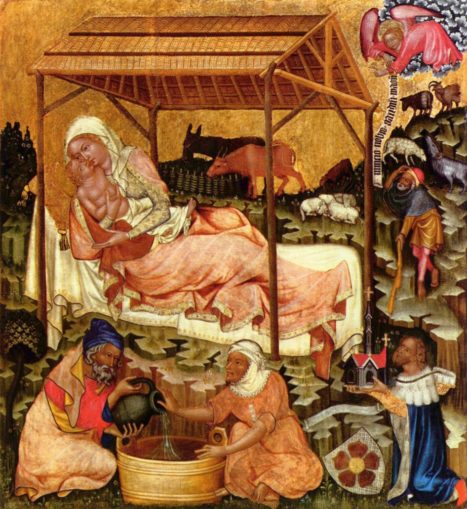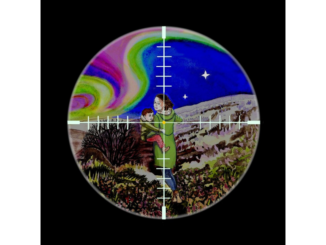
Master of Vyšší Brod, Mistr Vyšebrodský [Public domain], via Wikimedia Commons
Perhaps we are all so familiar with the story of the Nativity that we overlook much of its meaning, content and significance? I don’t want to focus here on the Incarnation of Christ, but on some of the ‘minor actors’ and ‘extras’, those who are only too easy to ignore and not regard as real people or things.
It is also important to remember that in the ancient world, writers were concerned with identifying and interpreting the significance of events metaphysical, historical and scientific, far more so than we are today in a world in which writing has become a utilitarian and materialistic pursuit in the main. Ancient writers, before printing when materials were expensive and fragile, and writing itself was laborious and time consuming, tended not to waste words. What we might regard as idle fables or picaresque scenes in their works all have an important meaning to their ancient authors. It is also highly arrogant of ‘moderns’ to regard ‘ancients’ as any more credulous or less intellectually sophisticated than we today – they were not, albeit they saw things differently to us – so some humility on our part is due when reading such of their output that has survived two millennia or more.
I have for over a year been looking at the major prophets of the Old Testament, their derivation, times of writing, identity, concerns and significance. I have learned a lot about what was preoccupying the minds of Jewish thinkers of the first millennium BC, and they were the intellectual creators of the Jewish world in which Christ and the first Christians resided. For me at least this process has instilled far more respect for them and their work, their significance for western thought and culture, and their importance to Christianity, its sense of itself and its world view.
Going forward, if spared, I want to tease out some of the common themes or threads that run through the Bible linking these books with those of the New Testament in the way that a cross thread helps knit together those threads running at ninety degrees to it to help form a narrative weave. Here considering some of the details of the Nativity we can see the themes of Jesus’ adult life already appearing, themes which are consistent with the Old Testament prophets’ battles against the Jewish elite’s repeated dabblings with paganism.
The Shepherds
Sheep were the backbone of the pastoral economy in Middle Eastern highlands such as Judaea both for nomads and settled peoples, and shepherds were therefore an archetype of the rural working class on the margins of society, an essential role requiring fortitude and courage in a land of wolves and bandits, but also far from the centres of power. It is why shepherds appear so frequently in Jesus’ teachings, they were culturally iconic for the average man and woman of the day.
In the Nativity story it is the shepherds among the Jews who heed God’s summons and appear at the stable, not wealthy and powerful Jews who are conspicuous by their absence. Combined with the fact that the birth takes place in a stable among animals, this signifies that Christ would be accepted by the ‘lower orders’ and rejected by the educated and wealthy. If it happened today, none of the media would show the slightest interest and those who normal people who did would be sneered at as being thick and credulous. As Jesus Himself was to say later, “It is harder for a rich man to enter the Kingdom of Heaven than a camel to pass through the eye of a needle.”
A stark warning to all in complacent and unprecedentedly prosperous Western societies which have large turned their backs on Christ as their wealth has increased. It’s no accident that Christianity spread first among the lower orders of the Jews and then the Roman Empire before then climbing its way up the social hierarchy.
The Three Kings/Magi
The Three Kings, in reality the Magi, who were technically an Iranian priestly class of the pre-Zoroastrian religion, but which here seems to refer more broadly to Babylonian, Chaldaean and Persian priests and scribes who doubled as astronomers and astrologers. They are the opposite of the shepherds – foreign, non-Jewish, wealthy and highly educated. Again, the Gospel writers are making the point that Christ’s message would in time get traction among non-Jewish elites but not among His own, as the first verses of John’s Gospel says, “…His own received Him not.”
The Choirs of Angels
Angel, from the Greek angelos meaning ‘messenger’. In nativity plays it adds a nice scenic touch for young children to play angels and sing, but the New Testament sees them as serious characters, Heralds of God and signs of His omnipotence, but also His self-restraint and latent power. What is interesting is how they bypass the Jewish priestly class and speak direct to the ordinary people as would Jesus later. A highly subversive act indeed, something that even today some of the more worldly and hierarchical Christian denominations would dislike (the human desire for status always creeps in to everything). It’s why I am deeply sceptical of a special sacramental priesthood.
Herod and the Massacre of the Innocents
So often seen as a bit of an after-thought in the nativity story, but this scene reminds us that from the moment of His birth, Christ was under sentence of death from the authorities of the day who wished to silence Him before He could speak and threaten their power. It points to His eventual execution alongside common criminals and that for much of its history, the Christian faith has been either corrupted or oppressed by the temporal powers of the day because they understand its threat to their own power. Today, Christianity, the world’s largest faith, remains the most persecuted, and even here in the so-called ‘tolerant Christian’ West, it is increasingly not tolerated and indeed attacked. To be a Christian is to be marginalised in the public sector, media and political world, a staggering turnaround in less than 50 years, and yet how often do we hear the leaders of the major Christian denominations raising this in public? If not, why not?
Furthermore, we live in a society that daily conducts its own massacres of innocents (over 200 thousand abortions a year in a land of freely available contraception, such that in some social groups the number of babies aborted is greater than those brought to term) and tens of thousands more abused, groomed, exploited, raped while the authorities turn a blind eye. We make Herod look like a small-town amateur, and we call it ‘a right to choose’, an act of female emancipation. Those who live in the darkness indeed cannot comprehend the light or the value of life.
Summary
Drawing these apparently bit part players together in the Nativity story, we can understand that they appear for a reason – they are predictive of the life and meaning of Jesus’ time of Earth, and the subsequent trials and growth of the faith He founded. These themes, among many others, run as cross threads unifying the narratives of the different books of the Bible into an impressively consistent whole. The ancient authors, and what/who inspired them, knew what they were doing, and what they were doing was radical indeed.
© 1642again 2019
The Goodnight Vienna Audio file
Audio Player


